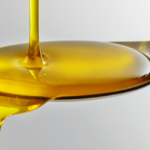The Healing Essential Fatty Acids, Part 2: Chemical Nature of Essential Fatty Acids

The usefulness of LA and ALA in our body results from their chemical properties.
EFAs attract oxygen. This property made EFA-rich oils useful to the paint industry as ‘drying’ oils, which dry and harden when exposed to air. Oils commonly used for this purpose were safflower oil: 80% LA; linseed oil: 50% ALA, 20% LA; and hemp oil: 55% LA, 20% ALA, and 2% GLA.
Fresh, these oils are excellent nutritional oils. Because they are chemically reactive, they increase oxidation and metabolic rate. Flax oil (the undenatured version of linseed oil) and hemp oil are nutritionally superior to safflower oil because they contain both EFAs (safflower contains only LA) and are chemically more active – they contain more double bonds in an equal number of oil molecules.

EFAs absorb sunlight. Their absorption of light energy increases about a thousandfold their ability to react with oxygen. This makes them chemically very active indeed.
Carrying slight negative charges, EFA molecules repel one another. This means that they do not easily aggregate, so they keep membranes fluid, a property that is important in membrane functions. Their tendency to disperse, called surface activity, gives biological systems the power to carry substances such as toxins to the surface of the skin, intestinal tract, kidneys, or lungs, where these substances can be discarded. The surface activity of EFAs also helps to disperse concentrations of substances that react with or dissolve in these fatty acids.
Their negative charge also makes the EFAs weakly basic (as opposed to acidic), and able to form weak hydrogen bonds with weak acid groups such as the sulphydryl groups found in proteins. Sulphydryl groups are important in oscillating reactions that take place between them and the double bonds of EFAs. They allow the one-way movement of electrons and energy in molecules to take place. The chemical reactions on which life depends require this one-way movement.
Because of their special arrangement, electrons involved in the double bonds of essential fatty acids can be induced to become loose and move as so-called de-localized pi-electrons that resemble clouds floating along the fatty acid chain.

EFAs can form phase boundary potentials, like charges of static electricity in a capacitor, which are caught between the water within and outside cells, and the oils within the membranes. These charges can produce measurable bio-electric currents, like the zap when static electricity discharges, which are important in nerve, muscle, heart, and membrane functions.





